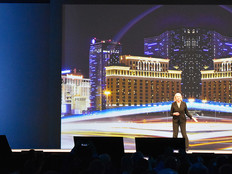HPE Discover 2017: Greater Network Intelligence Gives Businesses an Edge
For businesses with large offices spread across a campus, managed and streamlined Wi-Fi networks have long been a necessary element of IT infrastructure, and they have increasingly provided insight on traffic at the network edge. However, core network switches have remained largely stuck in the past and haven’t been able to shine much light on core network traffic.
Hewlett Packard Enterprise’s Aruba Networks unit this week unveiled a new switching platform to close that gap and bring network intelligence from the edge to the core network. Enhanced network intelligence gives businesses more visibility into potential issues — allowing them to predict or avoid problems — and also gives companies greater control over their networks.
This week at the HPE Discover 2017 conference in Las Vegas, Aruba unveiled the 8400-series switch to help on this front. The company also announced an asset tracking program to help companies wirelessly keep tabs on crucial connected devices and other assets.
Giving Businesses Greater Network Intelligence
At a keynote presentation on Tuesday, Keerti Melkote, senior vice president and general manager of Aruba, said that the core of campus networks “hasn’t seen a lot of innovation,” even as Wi-Fi networks have become more intelligent. Core network switches have largely remained the same, he contended.
“The world has moved on,” he said. “We’ve moved to a mobile-first world. And the core hasn’t changed.”
The 8400-series switch, Melkote said, will help companies “build out an entire footprint, a campus across multiple buildings, into a single architecture that is controlled, managed and secured using the same software.”
The brains of the new switch lie in its operating system, ArubaOS-CX, which the company says is designed for modern mobility, cloud and the Internet of Things. Melkote characterized it as a cloud app, running inside the network, that is scalable and integrated into all aspects of the core network.
Tom Black, vice president and general manager of campus switching at Aruba, wrote in a company blog post that today’s mobile-first business networks are crowded with cloud-based apps, which users access on various device types. This creates complexity in terms of data prioritization, segmentation and troubleshooting, he notes.
“For example, Skype for Business video traffic and Oracle month-end reports require a higher priority than other activities,” Black writes.
IoT devices also add management complexity “due to their varied connection protocols, divergent traffic patterns and, in most cases, insufficient security stacks,” Black writes. A spike in traffic by a specific IoT device could be either normal or concerning, he notes, but if that happens thousands of times across a network, it can create a lot of headaches for IT leaders and network administrators.
All of this means there are more devices and data on the network. “Finding the relevant bits of information among the deluge, and visualizing how that information correlates with other data and events on the network, is simply beyond manual human capabilities,” Black writes.
The switching platform’s ArubaOS-CX software has a built-in analytics engine, which Aruba states will allow IT staff members “to easily monitor network, system, application, and security-related activities with simple rules-based monitoring and automatic correlation of network activities.”
The analytics engine comes with a native time-series database combined with event correlation, to allow network operators to instantly detect problems, analyze trends, and then quickly predict or avoid issues that often lead to scale, security or performance bottlenecks, Aruba states.
The existing switching model for detecting network issues relies on users to identify a problem and report it to IT, Black notes, leading to delays in resolving the issues that impact overall enterprise productivity.
“For example, when business users experience a dropped session during a webconferencing call, they can’t notify the networking team until after the fact,” he writes. “Meanwhile, other users are also affected.”
The Aruba 8400 automatically detects traffic anomalies related to events — such as dropped calls or potential network attacks — and begins collecting additional data from the switch. Further, Black writes, “data from various sources is correlated, enabling an operator to see that a configuration change preceded a conference call event or that a suspicious traffic spike actually relates to normal utilization rather than an attack.”
Meanwhile, the Aruba 8400 also is fully programmable with a built-in Python interpreter and REST-based APIs for every function, the company states. “This allows for easy integration and ongoing flexibility with infrastructure and applications, including the Aruba Mobile First Platform, for end-to-end network monitoring, detection, troubleshooting, and closed-loop remediation of network performance or security-related issues,” the company notes in a release.
With the new platform, network operators can create programming and administration dashboards to fit a business’s needs. “Rather than using a generic dashboard, or waiting for a requested feature to be included in a new release, this capability boosts IT efficiency by placing the most relevant actions at your operators’ fingertips and enabling your staff to evolve the interface to meet new demands,” Black writes.
Tracking Assets in an IoT World
In a separate development at the conference, Aruba also introduced its asset tracking solution, which expands upon the company’s location services and mobile engagement portfolio to allow organizations — particularly those in retail and healthcare — to track critical assets, saving time and resources, as well as cutting costs.
As ZDNet reports, Aruba says “the new asset tracking solution addresses the problem of misplaced, lost, or stolen inventory in industries such as healthcare, retail, and warehousing, which can have a significant impact on overheads, staff productivity, quality of service, and revenue.”
The asset tracking solution includes new Bluetooth Low Energy (BLE) tags that can fit into the palm of your hand and an asset tag configuration application, according to Melkote, as well as advancements to ArubaOS and new features for the Aruba Meridian AppMaker.
Melkote notes that users can quickly search for assets via a mobile app, and then spend more time serving patients or customers.









